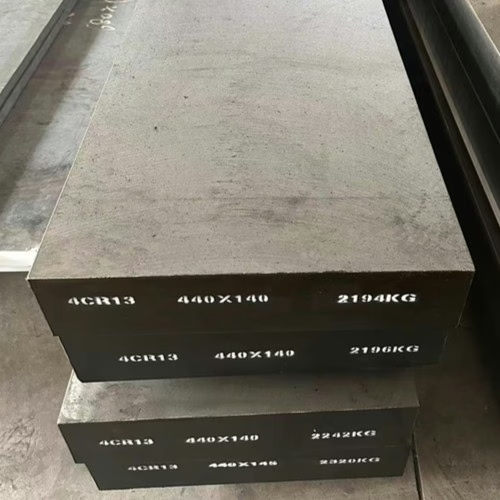4Cr13 Tool Steel Properties
At Aobo Steel, with our extensive experience in specialty steels, we frequently work with materials like 4Cr13 Tool Steel. This grade, sometimes referred to as 40Cr13, is a martensitic stainless steel known for its ability to achieve high hardness through heat treatment. It belongs to the chromium stainless steel family, where chromium is the key element providing corrosion resistance.
Understanding the properties of 4Cr13 is crucial for selecting the right material for your application.

1. 4Cr13 Tool Steel Chemical Composition
The typical chemical composition of 4Cr13 Tool Steel is generally within these ranges, though minor variations can exist based on the specific standard:
- Carbon (C): 0.36% – 0.45%
- Silicon (Si): ≤ 1.00%
- Manganese (Mn): ≤ 1.00%
- Chromium (Cr): 12.00% – 14.00%
- Phosphorus (P): Low levels
- Sulfur (S): Low levels
The significant carbon content enables this steel to be effectively hardened through heat treatment, while the chromium content contributes to its stainless properties.
2. Key Characteristics of 4Cr13 Tool Steel
2.1 Hardenability and Strength
4Cr13 offers good hardenability. Through appropriate quenching and tempering processes, it can reach significant hardness and strength levels. For example:
- Quenching from 1050-1100°C (typically in oil) followed by low-temperature tempering (200-300°C) achieves high hardness (often around 50 HRC or higher, depending on specifics).
- Higher temperature tempering (650-750°C) provides a better balance of strength, ductility, and toughness, albeit at a slightly lower hardness.
2.2 Corrosion Resistance
As a martensitic stainless steel, 4Cr13 Tool Steel provides good resistance to atmospheric corrosion, freshwater, and some mild chemical environments, including weak organic acids and dilute nitric acid at room temperature. However, its corrosion resistance is generally less than that of austenitic grades like 304 due to its lower chromium content. Always evaluate the specific operating environment to confirm suitability.
2.3 Wear Resistance
The ability to achieve high hardness after heat treatment gives 4Cr13 good wear resistance, making it suitable for components facing surface abrasion and friction.
2.4 Machinability
In the annealed (softened) condition, 4Cr13 can be machined using standard methods. However, machinability decreases significantly as hardness increases after heat treatment. This should be considered during manufacturing planning.
2.5 Weldability
Welding 4Cr13 is generally challenging due to its high carbon content and tendency to harden, which increases the risk of cracking. If welding is necessary, specific pre-heating, filler materials, and post-weld heat treatments are required.
3. Heat Treatment of 4Cr13 Tool Steel
Proper heat treatment is essential to achieve the desired properties in 4Cr13:
- Annealing: Heating to 750-800°C followed by slow furnace cooling softens the steel (typically 170-200 HB) for easier machining.
- Quenching: Hardening is achieved by heating to 1050-1100°C and then rapidly cooling the material. Oil quenching is commonly used for larger sections to minimize distortion; air cooling may be sufficient for smaller parts.
- Tempering: Performed after quenching to reduce internal stresses and adjust final hardness and toughness.
- Low Temperatures (200-300°C): Maximize hardness and wear resistance.
- High Temperatures (650-750°C): Enhance toughness and ductility, while slightly reducing hardness.
- Avoid Tempering Zone: Tempering between 400-600°C should generally be avoided, as it can cause temper embrittlement in some chromium steels.
4. Typical Applications for 4Cr13 Tool Steel
Given its properties, 4Cr13 steel is used in various applications, including:
- Cutting Tools and Blades: For applications requiring moderate edge retention and corrosion resistance, operating at temperatures below 300 °C.
- Wear Components: Parts such as guides, bushings, and pins are susceptible to abrasion.
- Valve Components: Seats or discs for lower pressure and temperature environments (below 400°C) that require some corrosion resistance.
- Fasteners and Shafts: Bolts, screws, pump shafts, and turbine components requiring higher strength than standard steels and moderate corrosion resistance.
- Plastic Molds: A common choice for molds where resistance to corrosive plastics is needed.
5. Selecting 4Cr13 Steel for Your Needs
When considering 4Cr13, evaluate the following:
- Service Environment: Analyze operating temperatures, stress loads, and potential corrosive agents.
- Required Properties: Define the necessary hardness, strength, toughness, and wear resistance for the application, which will guide the heat treatment.
- Manufacturing: Assess machinability and weldability needs based on your production processes.
- Alternatives: Compare 4Cr13 with other grades if requirements are demanding (e.g., austenitic stainless for superior corrosion resistance, other tool steels for maximum wear resistance).
Aobo Steel – Your Source for 4Cr13
Aobo Steel has over 20 years of experience forging and supplying tool and alloy steels like 4Cr13. We understand the technical requirements and can provide high-quality material processed to your specifications.
Contact us to discuss your specific application needs for 4Cr13 steel or to explore other suitable grades from our extensive range. We are here to help you find the optimal material solution.
Explore Our Other Products
D2/1.2379/SKD11
D3/1.2080/SKD1
D6/1.2436/SKD2
A2/1.23663/SKD12
O1/1.2510/SKS3
O2/1.2842
S1/1.2550
S7/1.2355
DC53
H13/1.2344/SKD61
H11/1.2343/SKD6
H21/1.2581/SKD7
L6/1.2714/SKT4
M2/1.3343/SKH51
M35/1.3243/SKH55
M42/1.3247/SKH59
P20/1.2311
P20+Ni/1.2738
420/1.2083/2Cr13
422 stainless steel
52100 bearing steel
440C stainless steel
4140/42CrMo4/SCM440
4340/34CrNiMo6/1.6582
4130
5140/42Cr4/SCR440
SCM415
🔥 Special Offer: Get Instant Quote + Free Heat Treatment Advice for 4Cr13 Tool Steel
Looking for a reliable 4Cr13 tool steel supplier?
Aobo Steel offers factory-direct pricing, fast delivery, and over 20 years of forging expertise.
✅ Free Expert Advice: Not sure about heat treatment or machining? Our engineers will guide you.
✅ Fast Quote: Send your size or drawing, get a response within 12 hours.
✅ Bulk Discount: For orders over 500kg, enjoy extra savings.
✅ Quality Guarantee: Mill test certificates and full traceability included.
